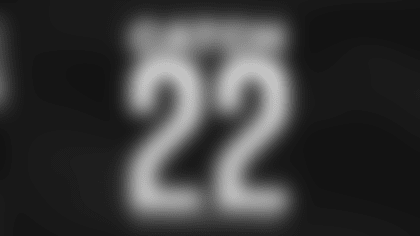The countdown to the 2025 NFL Draft is in full swing, with the scouting combine fast approaching in Indianapolis at the end of February.
At this stage, the hay is in the barn in terms of prospects putting actual football on film for teams to evaluate. The NFL Scouting Combine, Pro Days, private workouts, and '30' visits could break ties as the board is finalized, but the tape is king. Following a thorough film study of the consensus top prospects in this year's draft, let's get into some pre-combine tiers.
With the Patriots holding the fourth overall pick in the first round, it's a tricky spot for New England. There are good players in every draft, but unlike last year with QB Drake Maye at No. 3 overall, there isn't necessarily a home run option. The two blue-chippers, WR/CB Travis Hunter and EDGE Abdul Carter, could easily go in the top three unless quarterbacks Cam Ward and Shedeur Sanders push them down.
Speaking of quarterbacks, the Patriots aren't in the market for one, thankfully, with Maye secured, but it would behoove the Pats for Ward and Sanders to go in the top three. If teams don't reach on the quarterbacks, getting your hands on the best position players in the top 10 becomes a free-for-all. So, Pats fans should hope teams reach on the QBs or are enticed enough to offer a package to trade up to the No. 4 pick.
Here are my pre-combine rankings of the options for the Patriots at No. 4 overall.
Tier One: Run the Card Up if Available at No. 4 Overall (No Trade Down)
1. EDGE Abdul Carter, Penn State
Pro Comparison - Micah Parsons Lite
My reasoning for having Carter over Hunter is that it's easier to project Carter's role at the next level. Carter is the draft's best blend of seamless role projection (impact EDGE) and blue-chip athletic talent. Hunter is great, but determining which side of the ball he'll primarily focus on adds some uncertainty. Plus, Carter only played one season as a full-time edge rusher in college, so he's just scratching the surface of what he can become when his feel for the position improves.
Carter's tape is littered with splash plays in the backfield due to his electric first-step quickness, bend to turn a tight corner, and twitched-up movements to win inside. He also has high-end closing burst to finish sacks, range to make plays up and down the line of scrimmage, and can convert speed-to-power effectively. Carter adds value as an in-line rusher over the interior and as a QB spy, with his experience as an off-ball linebacker helping him play on the inside. Once he gets more reps on the line of scrimmage, Carter's block recognition vs. the run and hand technique as a pass rusher will improve, giving him a sky-high ceiling to be a nightmare for opposing offensive lines.
2. WR/CB Travis Hunter, Colorado
Pro Comparison - DeVonta Smith (WR), Sauce Gardner (CB)
Although his two-way abilities are part of the intrigue, whoever drafts Hunter will need a plan for his primary position in the NFL. Hunter is a special athlete who could succeed at either corner or receiver. However, there needs to be organizational symmetry on Hunter's ideal position because playing both ways like he did in college is unrealistic. That said, my take on Hunter that breaks from the consensus is that he should primarily focus on playing wide receiver in the NFL.
As a receiver, Hunter has game-breaking play speed with natural instincts for uncovering vs. zone coverage and excellent hands to catch everything thrown his way, using great body control to win contested catches (64.7% contested catch rate). The Colorado product also worked well with Sanders off-script, a skill that would serve him well if he's paired with Maye. Hunter will need to sharpen some route-running details vs. man coverage like releases vs. press-man and learning how to attack leverage with more dynamic stem work. But it's hard to envision an NFL team seeing Hunter's big-play ability and opting not to feed him the rock on offense.
Hunter's dynamic playmaking ability makes him a more intriguing receiver, but he's also easy to project at corner. The Heisman winner's best trait is his click-and-close as a ball-hawking zone defender, whether playing cloud/cover-two or playing the ball downfield in cover-three/quarters. Hunter is probably best used in a zone or match coverage-based system. However, his foot quickness, long speed, and length, which translate to receiver, also allow him to succeed in man coverage.
From a football standpoint, the only knock on Hunter is that his frame is a bit slender at roughly 185 pounds. That could cause some to pause about him withstanding the punishment of being a high-volume receiver. Still, as a 21-year-old prospect who just won the Heisman as the first true two-way talent in decades, Hunter will be an instant-impact star.
Tier Two: Realistic Options at No. 4 Overall (No Trade Down)
Before we get into the prospect breakdowns, this tier will probably create the most debates among Patriots fans over the next few months. Realistically, New England will be looking at these two players as the top prospects on the board when they're on the clock, assuming that Carter and Hunter are selected in the top three of April's draft.
3. OT Will Campbell, LSU
Pro Comparison - Ryan Ramczyk
By now, most of you probably know that there are doubts about Campbell sticking at tackle in the NFL, with some projecting him to move inside to guard. However, Campbell can compensate for his lack of length with sound technique and top-tier athleticism, flashing excellent footwork, balance, and a stout anchor. Based on him donning the No. 7 patch on his jersey at LSU, it's also worth mentioning that Campbell's football character is excellent.
Campbell wins with controlled, balanced movements in pass protection to mirror pass-rushers on an island. Simply put, you're not getting around his edge, and even when longer rushers get into his body, he can drop anchor quickly enough to avoid it being a deal-breaker at tackle. Campbell is also a dynamic run-blocker with the range to get into space, rhythm to execute combo blocks, and a twitched-up upper body to generate movement on the line of scrimmage. The LSU product plays with a nasty demeanor to his game, checking the "effort and finish" box that head coach Mike Vrabel wants to instill in the culture in New England.
My concern with Campbell remaining at left tackle as a pro isn't about his arm length. Instead, it's that he tends to overshoot his landmarks by drifitng in his pass sets, inviting rushers to beat him to the inside with spins or crossover rushes. In theory, that's fixable, but the detractors will say he's overcompensating for his lack of length by aggressively setting to meet rushers at the apex. If that's the case, it could be an issue.
Overall, Campbell is the draft's best offensive lineman, and the Patriots finished the 2024 season ranked last in pass and run-blocking win rate. It's easy to understand why he would be the pick for New England, and his tape suggests he can remain at tackle to start his career.
4. DT Mason Graham, Michigan
Pro Comparison - Christian Wilkins
From this perspective, Graham is the last prospect you'd feel comfortable with the Patriots selecting at No. 4 overall without trading down. As the Super Bowl champion Eagles showed, pressuring the quarterback, particularly through the middle of the pocket, is a must. Last season, the Pats were last in sacks (28) and 29th in pressure rate (28.7%). It's an area where they must upgrade this offseason.
The Michigan product is an explosive, high motor rusher who gets on the edges of guards and centers in a hurry. Graham's best move is his arm over/swim, but he'll complement that with an effective two-hand swipe to create separation from blocks with violent hand usage. As a run defender, Graham flashes the ability to plug and shoot gaps. His press-and-shed ability is better than expected for a shorter-armed defender, but he'll need to be more consistent with his pad level and anchoring against double teams to play on all three downs.
Overall, Graham projects as a pocket-disrupting three-technique with a hard-charging style of play. There's a lot to like about his game, but there's a positional value discussion to be had here, especially given how loaded the draft class is on the interior defensive line.
Tier Three: Options After a Trade Down (6-15 Range)
5. TE Tyler Warren, Penn State
Pro Comparison - Baby Gronk
When it comes to offensive centerpieces, who are we in New England to turn our noses up to building a productive passing game around a stud tight end? We know all about that. To be clear, Warren isn't Rob Gronkowski. Nobody is Gronk. But, in my time doing this, the 6-6, 260-pound tight end is the closest thing traits-wise to the future Hall of Famer.
Warren plays to his incredible size as an above-the-rim artist and lethal red-zone threat. He also has deceptive burst through the top of routes to create separation, is tough to bring down due to his size after the catch, and can run routes from all over the formation. Warren is great at winning leverage, using his large frame to shield the catch point while working the inside track up the seam or across the field. Warren sometimes gets too high as an in-line blocker, but he can move defenders of all kinds and block from multiple spots. Warren is an older prospect, but that also means he's ready to make an instant impact at a position that can take time for prospects to develop.
Maye has shown a penchant for throwing to tight ends, and OC Josh McDaniels will know how to feature Warren, who carried the Penn State offense to the CFP semifinal last season.
6. LB Jalon Walker, Georgia
Pro Comparison - Zack Baun
Walker is a do-it-all defender in a similar mold to past Pats linebackers. Walker can be an impact defender in the front seven as an off-ball linebacker and situational pass rusher off the edge, like the Pats used to use Dont'a Hightower, for example. His thick build allows him to pack a punch on contact, but he also has the range and athleticism to make plays in space. As a pass-rusher, Walker's speed off the edge is too much for tackles, and his quickness is too much for guards. The Patriots will probably have bigger needs, so we won't spend too much time on Walker, but he is a baller.
7. TE Colston Loveland, Michigan
Pro Comparison - Brock Bowers Lite
If Warren is baby Gronk, Loveland is the closest thing to Brock Bowers in this draft. At 6-5, 245 pounds, Loveland is an explosive mover who runs routes like a wide receiver in a tight end's body. It's awesome to watch how dynamic Loveland is as a route runner. The Michigan product threatens defenders early in the route by eating up off-coverage cushion, challenges second-level defenders up the seam, and has separation quickness on his horizontal cuts.
Loveland's best route is the "quick" post, where he can close down and cut across the face of defenders or climb past the second level with excellent burst off the line. Loveland is also a natural hands catcher with smooth transitions into YAC mode to create after the catch. The reason he's ranked slightly lower than Warren is because Loveland doesn't offer as much upside as an in-line blocker, but he can hold his own blocking DBs and on the perimeter. As far as dynamic pass-catchers go, Loveland is it.
8. WR Tetairoa McMillan, Arizona
Pro Comparison - Drake London
McMillan is a popular prospect amongst Patriots fans because he plays wide receiver. However, he's a notch below a typical top-five receiver prospect in a weaker first-round WR class. McMillan would enter the discussion for me as WR5 in last year's loaded first round, a tier below Marvin Harrison Jr., Malik Nabers, Rome Odunze, and Brian Thomas Jr.
At 6-5, 210 pounds, McMillan runs routes like a receiver in a much smaller frame but has the catch radius and body control to win contested catches at a 60 percent rate. He's a glider with extremely fluid movements for his size who can sink-and-cut through the break point to create separation, work middle of the field zones, and has stop-on-a-dime ability on comebackers. Due to his size, McMillan can drag smaller defenders for yards after catch. He isn't considered as high-end as the top receivers in last year's class because McMillan lacks playmaking gear to run through defenses or pull away from man coverage. He'll need to run his vertical routes more urgently.
Overall, selecting McMillan with a top-five pick seems rich. Still, if the Patriots address the trenches through the veteran market, McMillan has the athletic gifts that teams covet in a WR1.
9. CB Will Johnson, Michigan
Pro Comparison - Christian Benford
To accurately represent Johnson's pro ceiling, one must evaluate his 2023 film, where he anchored the backend for the then-national champs. Johnson, who has known he'd be a top prospect in 2024 for over a year, battled a turf toe injury that limited him to six games in 2024. The Michigan product is a calm, fluid mover who trusts his technique and plays with very little panic in his game. He's at his best playing off the line of scrimmage, where he can read and react from his pedal to break on the ball and give himself some cushion to match vertical speed.
Michigan ran a zone coverage-heavy system in Johnson's time in Ann Arbor, so he only played man-to-man at a 13.7% rate in 2024 (24.3% in 2023). There's evidence on film that he has the swivel hips and length to stick to receivers in man coverage, but there are some questions about Johnson's long speed to carry verticals and eye discipline to stay at home on double moves and fakes. Johnson could create a "no-fly zone" as the field corner opposite Christian Gonzalez, but there aren't many pure press-man reps to get a great feel for Johnson in a man-heavy scheme.
10. OT Kelvin Banks, Texas
Pro Comparison - Darnell Wright
Opinions are all over the map in the draft community with Banks. The consensus boards have him in the 10-15 range in the first round, but some have him in the 20s. Banks has some technique breakdowns that lead to quick losses, particularly when he's asked to change directions to stay square to blocks. Banks's sustain skills are also shaky, as he'll fall off blocks in the run game, leading to a lack of finish on contact.
Although there are concerns with his tape, Banks checks boxes with his tackle measurables and raw power to generate movement in the run game. The Texas product is a high-end run blocker who can create rushing lanes on double teams, turn and displace defenders in one-on-one engagements, and work up to the second level to lead block downfield. He also maintains inside-out leverage in his pass sets, forcing rushers to take longer paths to the quarterback around his edge.
With a new regime taking over, it's tough to say what an ideal Vrabel offensive tackle is. Based on McDaniels's past, Banks projects nicely as a people-moving OT. He has a higher ceiling in the pros, but think someone like Marcus Cannon forming a stout right side with RG Mike Onwenu.
Tier Four: Honorable Mentions, Injured Tackles and a Running Back
EDGE Mykel Williams, Georgia
Pro Comparison - Greg Rousseau
If the Patriots were in a different spot, Williams is a ball of clay they could give to Vrabel and DC Terrell Williams to develop into an impact defender. Williams has excellent first-step quickness, length, and change of direction talent. However, he's a bit raw right now with his pass-rush plan and counters. Williams will be a good pro with some coaching.
OT Armand Membou, Missouri
Pro Comparison - Zach Tom
Membou is climbing up media boards as the process continues due to his excellent feet, raw power, and range in the run game and pass pro. However, he's a shorter prospect (6-3) with shorter arms (33 ⅛") who solely played right tackle at Mizzou—a good football player who probably doesn't make much sense for the Patriots.
OT Josh Simmons, Ohio State
Pro Comparison - Christian Darrisaw
Simmons is this class's best pure left tackle based on his athletic traits and film to start the college season. He's an explosive, controlled mover with ideal measurables to play the position who was dominant against lesser competition. However, a season-ending injury knocked Simmons out for the year before the Buckeyes played the meat of their schedule, so nobody knows if his dominance would've continued vs. stiffer competition. Plus, his torn patellar tendon injury suffered last November kept Cole Strange off the field for a calendar year. Simmons might not even be available as a rookie. If he was healthy, we'd be having a different conversation. For now, he's a candidate for the Patriots in the second round due to his injury.
RB Ashton Jeanty, Boise State
Pro Comparison - Maurice Jones-Drew
We can't make this list without mentioning Jeanty, who has elite explosiveness and contact balance. However, if the Pats draft a running back with their first pick, you'll find me on the side of the Tobin Bridge.
DISCLAIMER: The views and thoughts expressed in this article are those of the writer and don't necessarily reflect those of the organization. Read Full Disclaimer







































